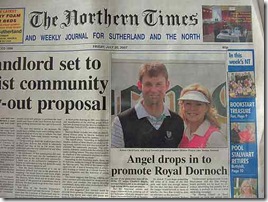>
Jay Ehret is on a blogging break and will return with regular posts October 13th. Until then, please enjoy a great line up of guest bloggers.
By David Mullen
Being quoted in a newspaper article or having your business featured in a local TV news segment is exciting, but the real payoff isn’t in higher endorphin levels. Generating news about your small business can increase awareness of your company, create leads and help ring the register.
Of course, getting ink is easier said than done. Over time, you can begin to identify what types of news are more likely to get the attention of an editor or assignment desk. That’s what I’ve done and today I’m going to pass along those insights to you.
 |
| Photo credit: foxypar4 |
1. Introduce yourself. The first thing you should do is identify key media outlets in your area and business reporters who cover topics or industries similar to your field. Email them a short bio on yourself that outlines topics on which you could serve as a knowledgeable resource. Let them know that you’d be more than happy to help them round out a story any time they’re looking for an opinion on one of those topics.
Follow up a week later with another email asking if you can grab coffee together and chat about what stories they’re working on. At this point, you’re not going to pitch them any story ideas. It’s all about finding out what stories they’re interested in and how you can fill in any gaps. If a topic comes up that you have a point of view on, share it.
2. Think beyond the business section. Too often, small business owners only consider the business section when trying to land a story. Think about ways your business could be relevant for stories in other sections.
If you own a home improvement store, let the Lifestyle editor know if you’ve noticed more customers are staying put and renovating the house they own instead of buying a new one. Point to increased revenue over last year as evidence and remind him about the housing market woes and – voila’ – you’ve got a trend story that’s perfect for his section.
3. Look for trends. Journalists LOVE reporting on trends and surveys. When you read about trends in national media outlets or your industry’s trade publications, share them with the business reporters you’ve started a relationship with along with a note that has your perspective on how it’s impacting your business and the community.
4. Anticipate key dates. Finding ways to tie your business in with key dates is another great tool. It makes your news or your expertise timely. If you own a marketing agency, offer your perspective on how presidential candidates market themselves differently today than even four years ago. If you specialize in photography, offer tips to the family/parenting editor or Lifestyle editor on snapping perfect photos during holiday gatherings.
5. Seek out speaking opportunities. Every conference in the U.S. has speakers. You can pitch yourself for one of those spots. Check the conference’s Web site four-to-six months in advance and learn how to submit your bio and topic of interest for consideration.
Once you secure a speaking role, work with your contact at the conference to get a list of media attendees at least two weeks ahead of time. Email media contacts that you think would be interested in your topic based on their title and publication. Offer to set up one-on-one interviews with each of them before or immediately after your speech or panel. Give them a printed copy of your speech or talking points. Follow up by email to learn if they’re going to write a story and when so you don’t miss it.
Don’t forget about your hometown newspaper if the speaking gig is out of town. Let your business reporter contact(s) know you’re a featured speaker and what you’ll be talking about. Email a copy of your speech a couple days ahead of time, and offer to do an interview in advance, in case they’d like to run a story the day after your speech.
Arm yourselves with these insights, put them into practice and you’ll give yourselves and your businesses a great chance at becoming media magnets.
About the author
David Mullen has helped shape communications strategies and manage their executions for a variety of brands, including The Home Depot, Coldwell Banker, Sealy and EMBARQ. He blogs regularly on PR and integrated communications at his little corner of the online world: David Mullen
Related articles on customer engagement:
Cracking The PR Code, Part 1: The Code Crackers
Cracking The PR Code, Part 2: The DNA of Publicity
Get Slightly Famous
Let future articles from The Marketing Spot come to you: Receive by Email or
